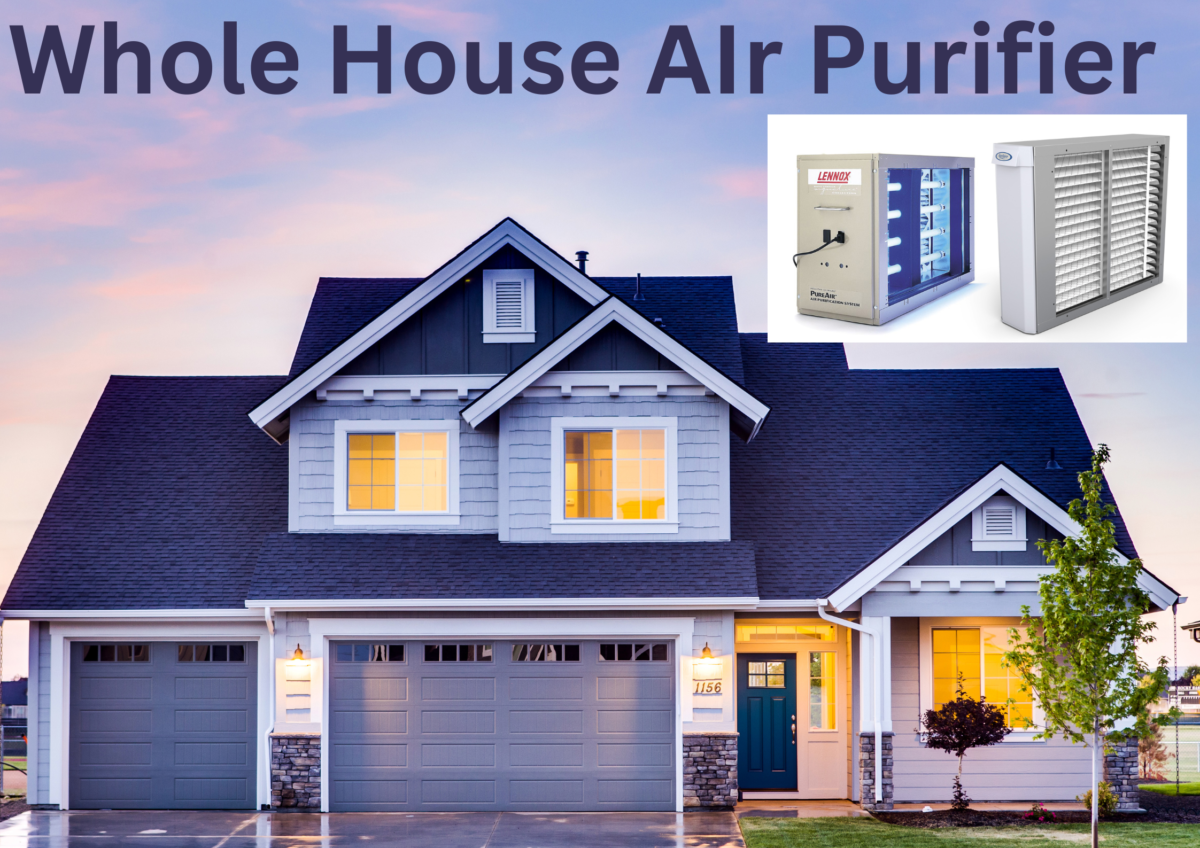According to the Environmental Protection Agency, indoor air can be up to five times more polluted than outdoor air. The dust on the table and the bookshelves is only a fraction of what is actually swimming around in the air. The dust mites, pollen, pet dander, airborne viruses, bacteria, harmful germs, etc. present in the air are hazardous to your health. The poor air quality harms people suffering from allergies, asthma, and other respiratory diseases.
To improve the air quality of the indoor area, the first thing recommended by a doctor is an air purifier. A portable air purifier is suitable for a single room. But if you live in a massive home it is always recommended to install a whole house air purifier. It is usually integrated with the centralized heating or cooling system so that the user can get the purified air at the desired temperature.
Wondering, if a whole-house air purifier is right for you or, not? Before purchasing a whole-house air purifier you must know detailed information about its types, working principles, pros, cons, etc. Read the full article, get a clear idea, and purchase the best whole-house air purifier for your home.
What Is a Whole House Air Purifier?
Whole house air purifiers are devices that remove pollutants including dust mites, pollen, mold spores, pet dander, smoke, VOCs, etc. from the indoor air of an entire house. These devices are generally integrated with the centralized cooling or, heating system of a home.
The main aim of a whole-house air purifier is to improve the air quality inside a home. While the centralized HVAC (Heating, Ventilation, and Air Conditioning) system supplies air with the desired temperature, it is not efficient in enhancing the air quality. However, an integrated centralized HVAC system with a whole-house air purifier system controls both the temperature and air quality of an entire house.
Types of Whole House Air Purifier
An air purifier has 2 important components i.e., a fan to pull the surrounding air inside the device and a filter that traps the airborne pollutants, harmful contaminants, and chemical gases from the air. Based on the various filtration techniques, whole-house air purifiers are mainly categorized into 4 types.
- Flat filters:
Flat filters are usually fiberglass or pleated. These are traditional filters for residential HVAC systems.
- Extended media filters:
These filters stack on top of one another to create an extra thick filter. This type of filter needs a large filter compartment to be fitted into the ductwork. Extended media filters are more effective than regular fiberglass filters.
- Electronic filters:
The working principle of an electronic filter is the same as an electrostatic filter. It contains a mesh of wires to create an electrostatic field. When the pollutants get inside the filter they become electrically charged and attracted to the oppositely charged collection tray. These types of filters can capture the smallest particles.
- Ultraviolet filters:
These filters use ultraviolet light to kill bacteria, viruses, and germs in the air.
How Does a Whole House Air Purifier Work?
Flat Filter Type Whole House Air Purifier
- This air purifier operates through the process of straining.
- The fan inside the device pulls the surrounding air into it. When the air reaches the filter media, it traps all the particles from the air, and the purified clean air recirculates back into the room.
- This process repeats several times an hour to enhance the air quality.
- Some flat filters utilize pleated filtering materials to offer a large surface for filtration.
- These air purifiers have a MERV rating between 5 to 8 which implies that they can remove 80 to 90% of the particles from the air. These air purifiers can trap particles of 3 microns or larger in size.
- Flat filter type whole house air purifier usually used in a wide range of commercial and institutional fields.
Extended Media Filter Type Whole House Air Purifier
- Extended media filters stack on top of one another to create an extra thick filter.
- This air purifier has several boxy units. Each boxy unit contains an accordionlike pile of filtration media.
- This 8-inch thick filter is connected directly to the HVAC system ductwork.
- The surrounding air passes over this thick filter, where the filtration process occurs and the purified air is then circulated back into the room.
- This type of whole-house air purifier is more efficient than regular fiberglass filters.
- These filters need to be replaced once in a year.
Electronic Filter Type Whole House Air Purifier
- These types of air purifiers are incorporated into the ductwork. These devices are installed professionally with the centralized HVAC systems.
- The returned air passes through the ductwork where the high-voltage current puts an electrical charge on particles.
- The oppositely charged collection tray attracts these charged particles and traps them in it.
- The air free from unwanted particles, contaminants, and chemical gases circulates inside the room.
- These types of filters never need to be replaced. The collection tray must be cleaned regularly in soapy water.
- These types of whole-house air purifiers are best for removing chemical gases, smoke, VOCs, etc. from the air.
Ultraviolet Filter Type Whole House Air Purifier
- These types of air purifiers use ultraviolet rays to kill germs, bacteria, airborne viruses, and biological contaminants in the air.
- The use of ultraviolet filter-type air purifiers is seen inside hospitals with tuberculosis wards.
- These air purifiers also have some side effects due to the emission of ultraviolet rays. It also causes several health issues.
How Effective Are Whole House Air Purifiers?
A whole-house air purifier is very effective and it is absolutely worth the money. It is an essential device for homes in polluted areas. It removes air pollutants, dust mites, airborne viruses, bacteria, germs, unpleasant odors, etc. from the air. This device helps in reducing the symptoms of allergies, asthma, and other respiratory diseases.
In urban areas, thousands of cars and industries release chemical gases and ground-level ozone which is dangerous for human health. If you are staying in a polluted area and your house is massive, then installation of a portable air purifier is not recommended. There are chances that the purified air again gets contaminated by the pollutants from the other rooms. So, in this case, the installation of a whole-house air purifier is the best decision. It provides purified air with the desired temperature.

Pros And Cons of Whole House Air Purifiers
Pros of Whole House Air Purifiers
Improves air quality:
It removes pollutants, dust mites, small particulates, airborne viruses, germs, bacteria, etc. from the air. Thus, it improves air quality and offers a healthy environment to live.
Removes Unpleasant Odors:
A whole-house air purifier removes chemical gases, VOCs, and unpleasant odors from the surrounding air. It makes the air fresh, clean, and healthy to breathe.
Prevents Respiratory diseases:
It removes dust mites and allergens from the air which triggers allergic and asthma symptoms.
Prevents airborne diseases:
A whole-house air purifier kills airborne viruses, bacteria, germs, etc. present in the indoor air. Thus, it prevents airborne diseases such as colds, coughs, etc.
Cons of Whole House Air Purifiers
Expensive:
A Whole-house air purifier ranges between 400$ to 4000$ depending on its filtration technology and efficiency.
Requires Regular Maintenance:
You will need to change the filters regularly and keep the device clean to get the maximum benefit. Some filters need replacements and also cost very high. It leads to an increase in maintenance costs.
Whole House Air Purifiers vs. Portable Air Purifiers
| Whole House Air Purifiers | Portable Air Purifiers | |
| Capacity | It purifies all air of an entire house with no boundaries. | It purifies a specific volume of air or, air in a specific room. |
| Requirement of HVAC System | Some models need an HVAC system for the installation of whole-house air purifiers. | It does not need any HVAC system or ductwork for installation. |
| Smaller Particle Filtration | Not very effective in filtering smaller particles as compared to portable ones. | More effective in the case of removing smaller particles. |
| Installation | You need professionals to install a whole-house air purifier in your home. | The installation process is easy and can be installed by the homeowners themselves. |
| Produced Noise | It produces little or no ambient noise during operation. | It produces more noise than whole-house air purifiers. |
| Single Unit / Multiple Unit | It is a single-unit system. It does not require multiple units to purify the air of an entire house. | A home needs multiple portable air purifiers to purify the air of various rooms. |
| Cost/ Energy Consumption | These devices are expensive and consume more electricity. | These devices are less costly and also consume less electricity. |

Conclusion
A whole-house air purifier is installed directly with the centralized heating or, cooling system. So, the purified air reaches every corner of a home. It removes contaminants, dust mites, and pollutants from the air, kills airborne viruses, bacteria, and germs, and also eliminates chemical gases, unpleasant odors, and VOCs, from the air. The filtration technique is the most important part of an air purifier. Based on this the air purifiers are categorized into various types.
The flat filter type whole house air purifier can remove 80 to 90% of the particles from the air. The extended media filters are more efficient than the regular fiberglass or flat filters. But to eliminate the smallest particles from the air electronic filters work the best. These filters are almost 30 times more efficient than regular fiberglass filters. But, the only disadvantage of this filter is that it produces ozone by-products which is not good for human health.
While purchasing a whole-house air purifier, make sure that the product emits within the acceptable range of ozone byproduct.
FAQS
- How much does a whole-house air purifier cost?
A whole-house air purifier costs within the range of 400$ to 4000$. The cost varies based on its type, filtration technique, efficiency rating, installation cost, etc.
2. Can an air purifier purify the whole house?
Yes, an efficient whole-house air purifier can purify the air in the entire house. As the system is integrated with the centralized heating or cooling system it reaches every corner of the house and circulates purified air at the desired temperature.
Also Read
- Air Purifier Advantages and Disadvantages
- How Do Air Purifiers Help? 6 Benefits
- Whole House Dehumidifier: Types, Working Principle, Pros, Cons 2024
- How Does a Commercial Dehumidifier Work? 2024
- How Does a Dehumidifier Work? Types, Uses, Benefits 2024
- 10 Tips for Buying a Dehumidifier
- Dehumidifier Vs Air Purifier 2024
- Dehumidifier vs. Air Conditioner 2024
- Cool Mist Humidifier: Types, Uses, Benefits, Working Principle 2024
- Do Humidifiers Help with Air Quality? 2024
- When Do You Need a Humidifier? 8 Common Signs
- How Do Humidifiers Work? A Complete Guide 2024
- How Humidifier Helps Breathing? 2024
- Humidifier Vs Dehumidifier Vs Air Purifier: Which One Should You Buy? 2024


15 thoughts on “Whole House Air Purifier: Types, Pros, Cons, Working Principle 2024”